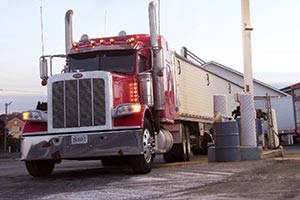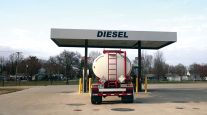Senior Reporter
Diesel Average Tumbles Below $2 for First Time Since February 2005

The national average retail price of diesel fuel fell below $2 a gallon, passing yet another long-standing threshold after setting an 11-year low the previous week, the Department of Energy reported.
Diesel dropped 2.8 cents to $1.98 on Feb. 15, based on DOE’s weekly survey of fueling stations. Diesel has fallen 50.2 cents over 14 consecutive weeks and was last below $2 on Feb. 14, 2005.
DOE’s Energy Information Administration also said the average price of gasoline dropped 3.5 cents a gallon to $1.724, also on Feb. 15.
Regular gasoline prices moved below the $2 per gallon mark on Jan. 11.
Diesel prices have tended to be higher than gasoline prices in recent years, as a result of strong global demand for diesel, federal fuel taxes for diesel that are 6 cents a gallon higher than those for gasoline and the higher production cost of ultra-low-sulfur diesel, EIA said.
Diesel had last approached, but not gone below, the $2 mark in March 2009 during the Great Recession, EIA said.
“Low crude oil [prices], tons of supply of diesel, not a very cold winter — all of that is just overwhelmingly pushing diesel prices down, and it has been for the last 16 months, really,” Sean Hill, an EIA analyst, told Transport Topics.
Diesel is 88.5 cents a gallon cheaper than a year ago when it was $2.865.
Owner-operator Chad Boblett, who runs Boblett Brothers, in Lexington, Kentucky, said he “loved to take advantage of the low fuel prices.”
At the same time, he suggested that “fuel is so cheap it’s opened the doors for so many new carriers getting into this market.”
He also said the low prices are not enough to counter fully the falling basic freight rates, fewer loads and increased competition in the spot market, where he specializes in handling expedited loads.
“People always say, if you want to do better in this business, then save on fuel,” Boblett told TT. “How about we ask for 10 cents more a mile, [too]?”
Mark Montague, senior rate analyst with load board operator DAT Solutions, told TT that diesel prices are a significant influence on spot market freight and rates.
“The reason the linehaul component [of spot rates] is going down is there is less freight from the oil and fracking industry, less piping, drilling equipment and machinery moved, and fewer commodities to support that [community]. A lot of that moves on the spot market. So with less freight, linehaul rates fall,” Montague said.
He said flatbed rates in February were $1.68 per mile, down 15 cents from a year earlier.
“If a fleet has a mix [of trailers], it may be running more vans now, which puts more pressure on the van segment [in terms of additional capacity seeking those spot loads],” Montague said.
DAT said it operates a network of load boards and is a source of supply and demand trends, rate benchmarking and capacity planning information.
On Feb. 16, crude oil futures remained below $30 a barrel, closing at $29.04 on the New York Mercantile Exchange. On Feb. 17 the price popped back above $30, closing at $30.66 that day.
Bloomberg News said volatile oil prices are a sign that crude doesn’t have much further to fall, according to Goldman Sachs Group.
The oil market is currently “trendless” with increasing swings between $20 and $40 a barrel, analysts including Jeffrey Currie said in a note dated Feb. 15, Bloomberg said. Still, spikes that may drag prices to the “teens” won’t be a surprise because significant volatility is widely predicted, according to the investment bank.
Meanwhile, EIA said gasoline has fallen 30.4 cents over the past seven weeks when the price was $2.028.
Gasoline is now 55 cents cheaper than it was a year ago when the price was $2.274.
It fell in all regions except the Midwest, where it rose four-tenths of a cent to $1.522.
EIA noted diesel prices tend to vary less by region than gasoline prices do.
In 2015, the average range from high to low among diesel prices in the five Petroleum Administration for Defense Districts, three sub-PADDs and California averaged just under 50 cents a gallon, while the range for gasoline was just over $1, the agency said.
EIA said this difference in price ranges was largely because gasoline supply chains on the West Coast were adjusting to several refinery outages in 2015, tightening gasoline supplies and increasing prices.
From 2010 to 2014, regional diesel price spreads averaged 32 cents a gallon while gasoline price spreads averaged 57 cents, EIA said.




